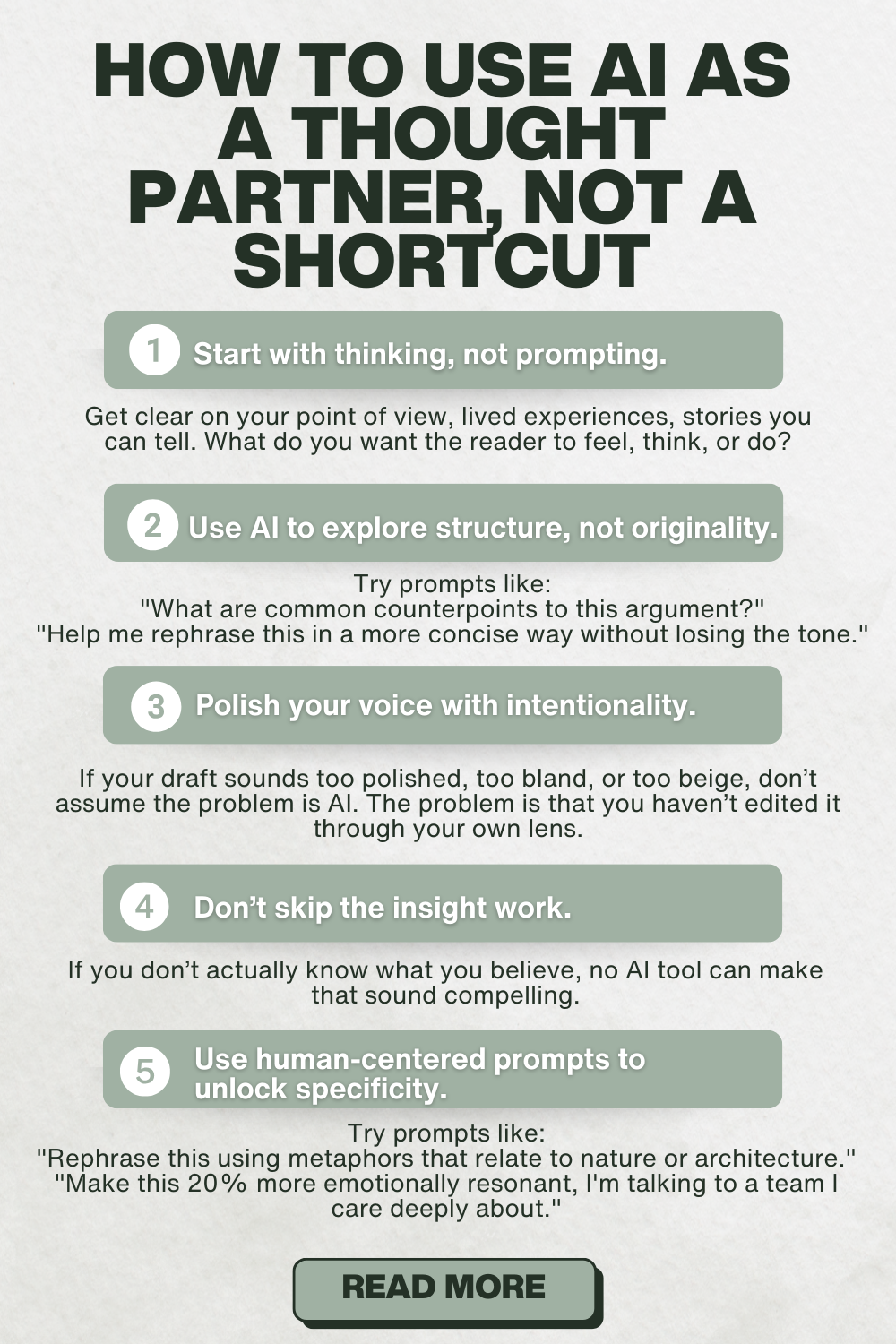
If you're worried that using AI to help you write will make your content sound inauthentic, you're not alone.
In the last year, criticism of AI-generated writing has exploded—especially in leadership and content marketing circles.
The telltale signs, they say, are everywhere:
- too many em dashes
- cliché phrases like "unlock your potential" or "uplevel your business”
- robotic sentence structure
- and a complete lack of originality
And while there’s truth to the idea that poorly used AI can dilute your message, that’s not actually the root of the problem.
The real red flag with AI content isn’t punctuation or buzzwords
It’s the lack of real thinking.
We don’t need more rules around what words to avoid or how many times to use a semicolon. We need more leaders willing to inject their own mind into the message.
Because the truth is: AI can’t hit publish for you.
If you’re putting ideas into the world that are meant to represent you—but they sound generic, hollow, or disjointed—it’s not the em dash that’s giving you away. It’s the absence of you in the work.
AI Writing Isn’t the Enemy—Thoughtless Communication Is
Professional writers have used em dashes—stylishly and intentionally—for decades. AI didn’t invent them.
But lazy thinking? That’s easier to spot.
The deeper issue is that most people are using AI like a shortcut instead of a thought partner.
They skip the messy thinking process. They let ChatGPT generate bland talking points and hit publish without filtering it through their actual perspective.
And that’s what your audience picks up on. Not the punctuation. Not the phrasing. The emptiness underneath it.
Let’s get real about human-sounding AI prompts:
If you’re just using AI to write faster and push out content, you’ll likely start to blend in with the masses.
But if you use AI to think better—to test an idea, pressure-test your logic, surface gaps in your structure, to push an idea a little harder—your content will still sound like you. It’ll just be sharper.
How to Use AI as a Thought Partner, Not a Shortcut
AI should enhance your insight, not replace it.
Here’s how to make sure that happens:
1. Start with thinking, not prompting.
Before you open ChatGPT, write down what you actually believe. What’s your point of view? What lived experience are you drawing from? What story can you tell? What do you want the reader to feel, think, or do?
Use this as your anchor. It doesn’t have to be polished—it just has to be real.
2. Use AI to explore structure, not originality.
Try prompts like:
- "Can you help me structure this idea into 3 clear takeaways?"
- "What are common counterpoints to this argument?"
- "Help me rephrase this in a more concise way without losing the tone."
These prompts keep you in the driver’s seat. The AI is supporting—not replacing—your core idea.
Tip: Always be sure to give AI as much context as possible: Who you’re talking to, your perspectives, your goals for the content… Let AI get to know the voice you want to convey.
3. Polish your voice with intentionality.
If your draft sounds too polished, too bland, or too beige, don’t assume the problem is AI. The problem is that you haven’t edited it through your own lens.
Tip: Read it out loud. Does it sound like something you’d say? If not, rewrite it until it does.
4. Don’t skip the insight work.
The most powerful writing—whether it’s a LinkedIn post, newsletter, or leadership communication—is grounded in clarity. If you don’t actually know what you believe, no AI tool can make that sound compelling.
Instead, slow down. Journal your way into the insight. Use a voice memo. Talk it through with someone. Then write. Then polish.
5. Use human-centered prompts to unlock specificity.
One of the fastest ways to make AI output sound more human is to build more human prompts.
Try:
- "Help me write this in the voice of a compassionate but direct leader."
- "Rephrase this using metaphors that relate to nature or architecture."
- "Make this 20% more emotionally resonant, like I'm talking to a team I care deeply about."
These tweaks inject tone, context, and humanity back into the output.

For Leaders: Why This Matters More Than Ever
If you're a founder, executive, or content-driven entrepreneur, your credibility is your currency.
Thought leadership isn't about publishing more—it’s about publishing content that actually reflects your thinking.
Train AI to help you write smarter, faster, and more clearly. But don’t let it replace your reflection, your perspective, or your standards.
Leadership communication isn’t about perfection. It’s about resonance. It's about crafting messages that align your team around a vision, inspire trust, and reflect who you are—even when you're moving fast.
AI can clean up your draft. But only you can say something worth reading.
The Future of Writing Is Collaborative—But Still Human
Here’s what’s coming next:
- More leaders will co-write with AI
- More teams will use AI to scale content
- More average content will flood every platform
The differentiator? Original thought, well expressed.
Your job isn’t to out-produce everyone.Your job is to say something true, clear, and useful—especially in a world full of fluff.
So by all means, use AI.But make sure your fingerprint is still on the work. That’s what earns trust. That’s what makes content unforgettable.
TL;DR: Want Your AI-Enhanced Writing to Feel More Human?
Here’s your checklist:
- ✅ Think first, prompt second
- ✅ Use AI for structure and polish, not core insight
- ✅ Read it out loud—make sure it sounds like you
- ✅ Add tone and intention to your prompts
- ✅ Never outsource the part where you decide what you believe
Because in the end, the best writing isn’t about how fast you wrote it.It’s about how clearly it reflects your mind—and how deeply it resonates with your reader.
Read more like this:
AI isn’t replacing you. It’s freeing you. (How to get back to what matters most)
AI prompt revolution. How to craft prompts that sound like YOU.
Get fresh takes on work-life alignment, leadership, and optimizing quality of life.


Member discussion